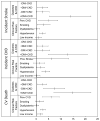Absolute Rates of Heart Failure, Coronary Heart Disease, and Stroke in Chronic Kidney Disease: An Analysis of 3 Community-Based Cohort Studies
- PMID: 28002548
- PMCID: PMC5832350
- DOI: 10.1001/jamacardio.2016.4652
Absolute Rates of Heart Failure, Coronary Heart Disease, and Stroke in Chronic Kidney Disease: An Analysis of 3 Community-Based Cohort Studies
Abstract
Importance: Cardiovascular disease is the leading cause of morbidity and mortality in patients with chronic kidney disease (CKD). Understanding the relative contributions of cardiovascular disease event types to the excess burden of cardiovascular disease is important for developing effective strategies to improve outcomes.
Objective: To determine absolute rates and risk differences of incident heart failure (HF), coronary heart disease (CHD), and stroke in participants with vs without CKD.
Design, setting and participants: We pooled participants without prevalent cardiovascular disease from 3 community-based cohort studies: the Jackson Heart Study, Cardiovascular Health Study, and Multi-Ethnic Study of Atherosclerosis. The Jackson Heart Study was conducted between 2000 and 2010, the Cardiovascular Health Study was conducted between 1989 and 2003, and the Multi-Ethnic Study of Atherosclerosis was conducted between 2000 and 2012.
Exposures: Chronic kidney disease was defined as estimated glomerular filtration rate less than 60 mL/min/1.73 m2, calculated using the combined creatinine-cystatin C CKD-Epidemiology Collaboration Equation.
Main outcomes and measures: Poisson regression was used to calculate incidence rates (IRs) and risk differences of adjudicated incident HF, CHD, and stroke, comparing participants with vs without CKD.
Results: Among 14 462 participants, the mean (SD) age was 63 (12) years, 59% (n = 8533) were women, and 44% (n = 6363) were African American. Overall, 1461 (10%) had CKD (mean [SD] estimated glomerular filtration rate, 49 [10] mL/min/1.73 m2). Unadjusted IRs for participants with and without CKD, respectively, were 22.0 (95% CI, 19.3-24.8) and 6.2 (95% CI, 5.8-6.7) per 1000 person-years for HF; 24.5 (95% CI, 21.6-27.5) and 8.4 (95% CI, 7.9-9.0) per 1000 person-years for CHD; and 13.4 (95% CI, 11.3-15.5) and 4.8 (95% CI, 4.4-5.3) for stroke. Adjusting for demographics, cohort, hypertension, diabetes, hyperlipidemia, and tobacco use, risk differences comparing participants with vs without CKD (per 1000 person-years) were 2.3 (95% CI, 1.2-3.3) for HF, 2.3 (95% CI, 1.2-3.4) for CHD, and 0.8 (95% CI, 0.09-1.5) for stroke. Among African American and Hispanic participants, adjusted risk differences comparing participants with vs without CKD for HF were 3.5 (95% CI, 1.5-5.5) and 7.8 (95% CI, 2.2-13.3) per 1000 person-years, respectively.
Conclusions and relevance: Among 3 diverse community-based cohorts, CKD was associated with an increased risk of HF that was similar in magnitude to CHD and greater than stroke. The excess risk of HF associated with CKD was particularly large among African American and Hispanic individuals. Efforts to improve health outcomes for patients with CKD should prioritize HF in addition to CHD prevention.
Conflict of interest statement
None of the authors have a conflict of interest to disclose.
Figures

References
-
- Ferdinand KC. Coronary artery disease in minority racial and ethnic groups in the United States. The American journal of cardiology. 2006;97:12A–19A. - PubMed
-
- Taylor HA., Jr Establishing a foundation for cardiovascular disease research in an African-American community--the Jackson Heart Study. Ethnicity & disease. 2003;13:411–413. - PubMed
Publication types
MeSH terms
Grants and funding
LinkOut - more resources
Full Text Sources
Other Literature Sources
Medical
Research Materials
Miscellaneous

